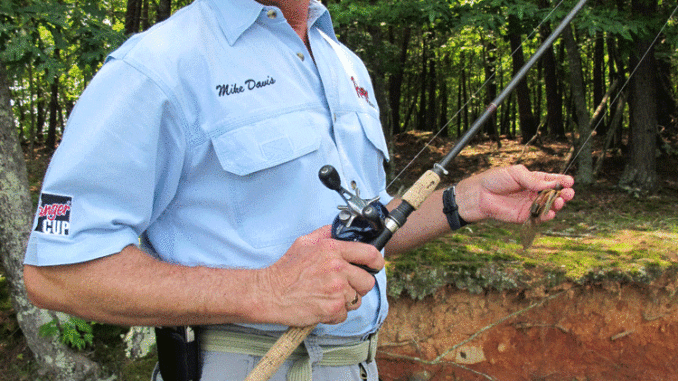
Chose your water — clear or dirty — and set out to catch that big bass this month by following these experts’ advice.
Badin Lake is full of big bass. To catch them this month, you’ll first have to decide whether you want to fish clean or dirty water. The clean water is for the patient fisherman who favors finesse techniques to catch spawning bass. The dirty water is for the power fisherman who loves to throw big baits into heavy cover.
Either way, a smart fisherman can have a great time on the water chasing big bass on this beautiful Piedmont reservoir, which covers 5,200 acres on the Yadkin River southwest of Denton. You just have to pick the style you prefer and let Kevin Chandler, Mike Davis and Chris Baldwin share their strategies, honed by years of putting fish in their livewells during tournaments.
Chandler and Davis, first-cousins from New London, have spent decades fishing Badin. Both like to power fish in dirty water. Baldwin, a taxidermist from Lexington, is drawn to Badi nby its extra-clear water; he loves to look for big female bass on their beds during the spawn.
Their tactics are certainly different, but they all catch big bass. Chandler and Davis are primarily fishing in or near the main river channel, while Baldwin is looking for the clearest water he can find in the backs of creeks farthest away from the effects of the current and prevailing winds.
One of Badin’s strengths as a fishery is that it can be approached in variety of ways and still spit out nice fish, and that’s true throughout the year. But April gives you more shots at big fish in shallow water than probably any other month.
“I’ve aways opted for the dirty water,” said Chandler, who doesn’t want to be able to see the fish and doesn’t want them to GUIbe able to see him. “I like the Old Whitney area from the ramp up towards (Tuckertown Dam). I’m looking for dirtiest water I can find. It gives me more confidence. It only took 30 years for me to learn this, but I do better when I fish my strength, and fishing dirtier water is my strength. That’s what I’m going to fish.”
Chandler oves fishing spinnerbaits and jigs around grass, docks and laydowns in April. He feels that bass are keying in on perch and gizzard shad, and both can be found shallow along the grass or in wind-blown pockets. Davis also likes dirty water, although cautions that water the color of a basketball is too dirty for anybody to fish, especially if that water is really cold.
“I love it really stained, where you can just see a spinnerbait seven inches deep,” he said. “A spinnerbait is a power-fishing technique. Crankbaits really start to be good in April, too. You’ve got your jig, and you’ve got your ChatterBait, which causes a lot of vibration when the water is dirty enough to use it.”
Of course, the biggest change in April is rising water temperatures that trigger the spawn as the mercury approaches 65 degrees. The weather plays a huge role in how and where you fish the dirty water. The water temperature will tell you whether you should be fishing deep or shallow, fast or slow and what kind of bait to use.
“If the water temperature is from 44 to 48 degrees, that’s when you pull out the Shad Rap or the Speed Trap,” said Davis, who throws these crankbaits off the bank a bit looking for fish before they head to their spawning beds. “I like 47, 48, 49 degrees. I’m not burning it (the lure). The bass are still sluggish, but they’re gorging out, and they really like crayfish. That gives them a lot of protein, a lot of energy. At about 48 degrees, they start pushing their way in shallow.”
This sets up the perfect scenario for Chandler: big fish that are shallow and tight to cover.
“I love to throw a spinnerbait, and I love to flip a jig. Those are my two favorite ways to fish,” he said. “In April, I’ll start throwing a spinnerbait out in front of the grass, out beside docks. Eventually, I’m going to get my jig out, and I’ll go flip some docks and some poles, because a lot of times those fish will spawn underneath those docks beside the poles. I think a lot of times you’re catching a fish (that is) spawning and you can’t tell they are because this lake usually has some color to it.”
Everything revolves around the spawn in April, of course. There is no doubt that any fisherman has to take this into account regardless of whether you are fishing dirty or clean water. It’s just that the approach is different.
Chandler’s big-fish approach works no matter where the bass are in the spawning pattern, mainly because the spawn lasts for so long and that the staging areas, spawning areas and post-spawn areas are so similar and located so close to each other.
“I think for the most part, the full moon in April is when the major spawn takes place,” said Chandler. “But I think there are fish that spawn at the full moon in March. I’ve always been told that the biggest fish are the ones that spawn first. I really think that these fish spawn every year in March. I don’t think a lot of them do, but I think the biggest fish spawn in March.”
The full moon in March 2012 was on the eighth. April’s full moon is on the sixth. Regardless, Chandler is catching these fish in April in the same places whether they are postspawn, prespawn or are actively on the beds.
“If I can flip a jig to a dock or a tree, I’d much rather catch them that like that,” Chandler said. “I like slow-rolling a spinnerbait around grassy points and docks for those bigger fish that spawned in March. It takes them about a week to 10 days to recover, and then they start to feed big time. And I’ve caught some awfully big fish slow-rolling a spinnerbait in April. These fish feed on perch and gizzard shad. They don’t go far until the water temperature gets so hot they can’t handle it, and then they go out deeper.”
If the water is really high in April, there is another shallow-water, power-fishing scenario that Davis will break out to fish the flooded brush that many bass will use as spawning cover.
“If the fish are in the bushes, then 30-pound braid or 20-pound fluorocarbon with a Big Mo’, a big lizard or a Brush Hawg tied to the end, and you can jerk them big 5- and 6-pounders out of those bushes.”
Chandler prefers spinnerbaits in white or chartreuse and jigs in green, brown, blue and black, reserving the latter for cloudy, rainy days.
Davis prefers War Eagle spinner baits in “spot remover,” blue herring and perch. He adds that a Hawg Caller spinnerbait is hard to beat as well. He fishes a 3/8ths-ounce spinnerbait near the bank and a 5/8ths-ounce bait when he is away from the bank to more easily cover the water column.
You won’t find Chris Baldwin of Lexington fishing that same dirty water. He likes it clean and clear, and he usually finds what he is looking for is the back of quiet, secluded pockets that get the most sun.
“One of my favorite places to sight-fish is Badin,” Baldwin said. “It is a lot clearer than High Rock, and it has that shell bottom that I like in many places. It has a lot of trophy bass in it.
“For the first fish that spawn, to me, the moon phase doesn’t have a lot to do with it; they go on temperature,. I like 60 to 65 degrees, preferably. That’s the first wave. They can be a little squirrelly acting until that water temperature does level out a little bit in that range.”
Baldwin looks for beds around docks, along grasslines and around stumps and bushes that provide cover for bass. He likes to find deep, clear water as well.
“The deeper water, the better, because they are easier to catch,” said Baldwin. “On Badin, four feet is pretty deep for a bedding fish, but it makes it harder for everyone else to see them, so they are easier for me to catch.”
When he finds bedding bass, he targets them with a Baby Brush Hawg in green pumpkin; this “creature” bait is effective both Texas-rigged and Carolina-rigged.
“I’m just slow, dragging it through the bed,” he said. “If that doesn’t work, then I like to use a white jig with a Critter Craw for a reaction strike. I like the fact that you can get a little better idea of the attitude of the fish if you can see them.”
Davis says areas for a good early-spawn bite would be those around Circle Drive, the Beaverdam Creek area, Glady’s Fork, as well as the Lake Forest/Fish Tales Marina area. These areas are well away from the main channel and usually offer the clearest water on the lake.
“Every fisherman I know looks forward to April,” Davis said. “There’s always a shallow bite somewhere, and there’s always a deep Carolina-rig bite somewhere.”
DESTINATION INFORMATION
HOW TO GET THERE/WHEN TO GO — Badin Lake is on the Yadkin River system southwest of Denton. Best access is from NC 109 from the east, from NC49, NC 8 and Badin Lake Rd. from the north and NC 8 and NC 740 from the west and south. The peak of the bass spawn is in April; prespawn, spawning and postspawn fish are available throughout the month in different areas.
TACKLE/TECHNIQUES — Medium action baitcasting tackle, 20-pound braid or 30-pound fluorocarbon for fishing the bushes. Lighter line for casting 3/8th- and 5/8th-ounce spinnerbaits and jigs around grass, docks and lay-downs in dirty water. Light-tackle baitcasting or spincasting tackle for clear-water, finesse fishing with soft-plastics on largemouth beds, or white jigs with a trailer.
GUIDES/FISHING INFO — Maynard Edwards, Yadkin Lakes Guide Service, 336-249-6782. Gill’s Tackle, Badin, 704-422-3111.
ACCOMMODATIONS — Badin Inn, 107 Spruce St., Badin, 704-422-3683. Sleep Inn & Suites, 621 SR 24-27 Bypass, Albemarle, 704-983-2770. Camping also available in Uwharrie National Forest, 910-576-6391, Morrow Mountain State Park, 877-7-CAMP-NC.
MAPS — Kingfisher Maps, 800-326-0257, http://www.kfmaps.com/; Navionics, http://www.navionics.com/.

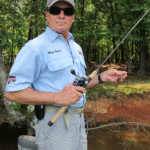
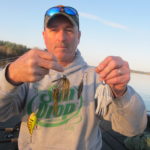
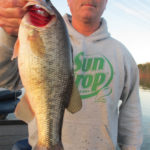
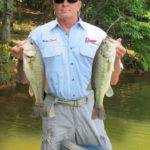



Be the first to comment